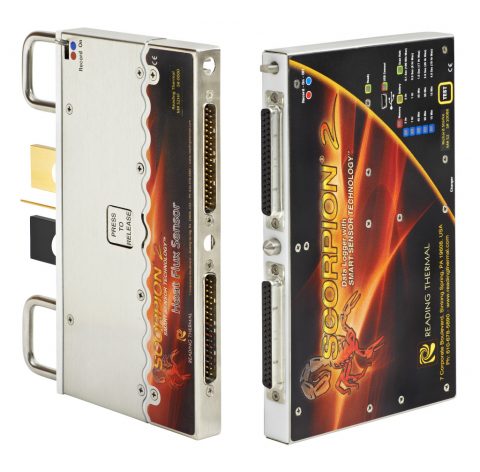When you need to measure actual in-process conditions in your industrial oven, the state-of-the-art Reading Thermal SCORPION® 2 Profiling System and Data Logger is a great solution.
Reading Thermal, a Reading Bakery Systems brand, is located in Sinking Spring, Pennsylvania. Our heat transfer experts have studied, measured, and understood commercial ovens for 25+ years. We manufacture and support the SCORPION® 2 Profiling System and Data Logger, a standard in the baking industry.
What Can Be Measured
Connecting our innovative smart sensors and sensor arrays to the SCORPION® 2 Profiling System and Data Logger and sending them through the oven along with your baked goods enables the system to capture the four primary baking parameters:
- Temperature (of the air and the oven belt surface)
- Heat flux (energy transfer)
- Humidity
- Airflow (velocity).
1) Temperature: Oven temperature affects oven-spring, drying/dehydration, and color formation during baking. Temperatures that are too low or too high can also lead to undesirable changes in texture and taste. The Scorpion® 2 Temperature Sensor Array measures temperature at the product level, in fixed positions on the conveyor, and delivers a detailed picture of temperatures from side-to-side and end-to-end.
2) Humidity: Humidity is the amount of water vapor in the air. While baking, your products use the available moisture in your oven. Without humidity, their quality and texture will not have the expected results. High oven humidity can lighten the crust color of baked goods and prevent them from burning. Lower humidity typically results in crustier bread. Global bakeries trust the SCORPION® 2 Digital Humidity Sensor to accurately measure the absolute moisture content of the thermal environment in heating and cooling processes.
3) Air velocity: Airflow comes primarily from the air distribution plenums in a convection oven. The airflow In a radiant oven comes from the moving conveyor, the exhaust system, and natural combustion air currents. Using the SCORPION® 2 Air Velocity Sensor to measure air velocity is crucial because airflow influences the final product’s texture, coloration, firmness, and baking time. The data will help you spot differences in airflow between baking zones and undesirable air currents at the entrance or exit of the oven that could be the cause of inconsistent baking.
4) Heat flux: The amount of energy transferred per unit area per unit time from or to a surface in the oven is defined as heat flux. It is the best indication of oven performance in terms of the product. Many bakeries use these data profiles when attempting to produce the same baked goods on two different lines or when transferring baked goods from one line to another. When the heat flux profiles match, bothlines will produce the same product. The SCORPION® 2 Heat Flux Sensor measures convective and radiant heat fluxes at the product level and displays the results in Btu/hr·ft2 or W/m2.
When your industrial oven calls for monitoring baking conditions, consider the state-of-the-art SCORPION® 2 Data Logger from Reading Thermal. Visit us online or call us at (610) 678-5890 Ext. 2 to learn more about it.

